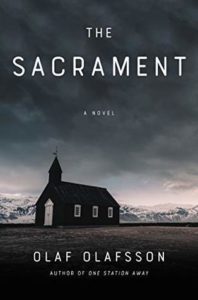Funny what you remember. All of it would go back in a drawer, far back in my head. Slammed shut.
My apologies up front for what follows may turn out to be a rambling mess of incoherent thoughts. Once I started reading Father Sweet, I could not stop reading and I could not stop thinking about it when I wasn’t reading it. I was thinking, thinking, always thinking about it and so much so that I had to turn off my audiobook on the commute to work because I wasn’t paying any attention to it. I thought so much about it that I even ran a red light. I gobbled this one down in 3 or 4 giant gulps. I remain deeply affected by this book.
Originally, I requested this one via Netgalley but my library brought it in so I put that on hold and was the first to crack open its pages. It sat there staring at me for a little bit, I was hesitant to pick it up and begin reading. Did I want to read something like this right now? Well, once I made the decision to start, I could not stop (repeated from above!).
Let’s start with the cover shall we? I think the design is brilliant. Is it designed to look like the Bible? It is very dark and ominous and this was perhaps part of my hesitation at first. The cover in the profile pictures shows the tent and the trees behind it as white. It’s not, it’s actually all black with just a slight shine of these two elements to bring it to our attention. I think this effect is excellent.
The next thing and it’s something that punches you in the face is the Author’s Note. A punch to the face and the gut and after reading it, the momentum and the effortless writing had me glued to its pages. Martin notes this is a work of fiction no matter how many of his former fellow parishioners at Good Shepherd Parish in Blackburn Hamlet recognize certain persons.
“What I have tried to do, however, is capture certain places and times, and maybe some shadows of truth. Hopefully nothing that matters has been lost. It is important to note that clerical abuse of authority, which has resulted too often in physical and sexual abuse, is real and ongoing. It is impossible to talk about clerical sexual abuse in Canada without mentioning the Church and the state’s exploitation of Indigenous communities, and the settler community’s failure to acknowledge and stop that abuse. The Canadian government colluded with Christian churches to abuse thousands of Indigenous children for generations. The last residential school was shut only in the 1990s.”
J.J. Martin, Author’s Note
I could include more of what he has to say in the Author’s Note, but really, I just strongly suggest you read all of Father Sweet and take his Author’s Note seriously. There is so much more in there and like Martin states, “Truth is so often worse than fiction.” I also want to note that what follows in Father Sweet is not sensationalistic At All. I cannot express that enough. It only sits on your brain, leaving you thinking, thinking, thinking.
What is inside is the beautifully written story about a 12-year-old boy that loves nature, loves the Scouts but not really school. He loves his brother Jamie too and that leaps out from every page.
“Scouts I loved. School, I hated. And then there was church.”
His writing is so effortless and engrossing. I consumed this book. Martin says in the Author’s Note he toned down much and what you’re reading just becomes this engrossing and finely nuanced story of a young boy that has had his world ripped from him, everything this 12-year-old boy held dear he abandons and struggles to build a life of normalcy. Martin’s writing conveys such love he has for his brother Jamie, the outdoors, his life as a Scout…it comes through clearly.
This is also the first book I’ve read that is written in the first person by a victim. Almost every book I’ve read addressing this issue has been from the priest’s perspective, whether they were directly or indirectly involved, complicit or not in their actions. Two stellar books such as John Boyne’s A History of Loneliness and Linden MacIntyre’s The Bishop’s Man come to mind immediately. Jennifer Haigh’s Faith and Crimes of the Father by Thomas Keneally and South of Broad by Pat Conroy also quickly come to mind. All of these were excellent to read, and none of them were sensationalist. There are never any ghastly details. I just keep feeling the need to impress this upon you. However, we cannot turn a blind eye to this, and I feel these books have undertaken this issue importantly and done so incredibly well with great feeling and emotion. (Sorry, see, went off on a ramble) (additional ramble, watch the Academy Award winning Spotlight too. There is a brief moment (it’s so brief you might miss it in Spotlight but the thread is there in Father Sweet.)
Part 1 takes place in 1978. These were the times you invited the priest over for dinner and his presence in your home was a great honour. When Father Sweet asks to take their son on a weekend camping trip, his parents are thrilled but our narrator is horrified. (You will find that the narrator to his story remains unnamed until the very end.) He leaves with Father Sweet listening to the admonishment of his parents telling him to do everything the good Father tells you to do and to not embarrass them. This camping trip has edge-of-your-seat elements to it, but also done in a highly nuanced manner. We’re left with some mystery as to what really happened to Jacob on this camping trip.
Part 2 begins in 2003. Our narrator well into adulthood but not handling it well. And it is in this part where we hear more about his father’s job in Indian Affairs with the Canadian government and what exactly his “work” entailed. He and Jamie have come to their childhood home to pack up its belongings following the death of their father. He discovers documents and letters detailing his father’s involvement supplying Indigenous children to priests and nuns. This horrific story of residential schools, the Catholic Church and the Canadian government needs no retelling from me here.
There were parts in Father Sweet that also reminded me of Keneally’s Crimes of the Father. In both books they address the church’s policy where children beginning at the age of 7 say confession.
“I don’t understand why,’ I said. ‘Teaching children that they are sinful and need to confess. Teaching children to be guilty. Even while lives are being ruined. Kids are dying. And I don’t understand why you, you priests are…so goddamned confident you are right.”
“Antonio, kids can’t sin. They can’t.”
Part 2 is a redemptive quest for our narrator and the time when he first begins to heal his wounds. He is able to confront Father Sweet after all this time and also works to save a child’s life. There are a number of issues and conspiracies raised in Part 2 but the ending is a good one for our narrator, and here is where his name is revealed, and the work he puts into his healing process.
Father Sweet deeply affected me. Again, I cannot and could not stop thinking about it. Will this be one we see longlisted for the Giller Prize in September?
A similar book, also from Netgalley is The Sacrament by Olaf Olafsson. I think I’ll need to sit with my thoughts from Father Sweet for a bit longer before I dive into The Sacrament.

Thank you to Dundurn, Netgalley and my library for putting Father Sweet in front of me. I certainly won’t be forgetting it for the foreseeable future.





Leave A Reply